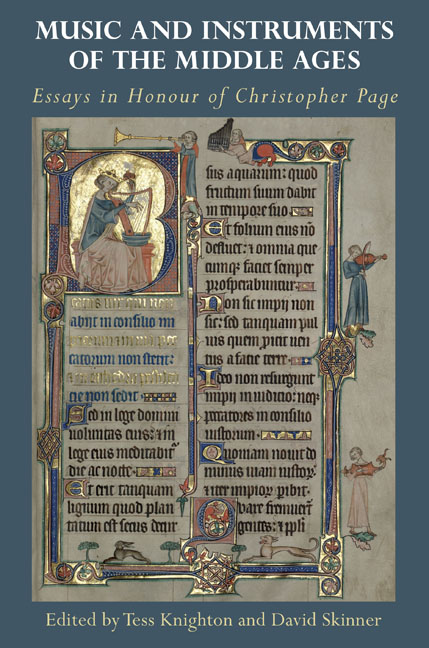Book contents
- Frontmatter
- Contents
- List of Illustrations
- List of Music Examples
- List of Tables
- List of Contributors
- List of Music Manuscript Sigla
- Acknowledgements
- Introduction
- SONGSTERS AND THEIR REPERTORIES
- CLOSE READINGS
- CREATING POLYPHONY
- MUSIC AS CULTURAL PRACTICE
- Works Cited
- Works by Christopher Page
- Index
- Tabula Gratulatoria
- Studies in Medieval and Renaissance Music
8 - Making Sense of Omnis / Habenti: An Ars Nova Motet in England
Published online by Cambridge University Press: 24 November 2020
- Frontmatter
- Contents
- List of Illustrations
- List of Music Examples
- List of Tables
- List of Contributors
- List of Music Manuscript Sigla
- Acknowledgements
- Introduction
- SONGSTERS AND THEIR REPERTORIES
- CLOSE READINGS
- CREATING POLYPHONY
- MUSIC AS CULTURAL PRACTICE
- Works Cited
- Works by Christopher Page
- Index
- Tabula Gratulatoria
- Studies in Medieval and Renaissance Music
Summary
The motet Omnis / Habenti / Tenor is found in only one source: the rear flyleaves of the book Oxford, Bodleian e Mus. 7 (hereafter Ob 7), fols 266v–267r, whose provenance can be reliably connected to the Benedictine abbey of Bury St Edmunds. As is typical of fourteenth-century insular polyphony, its texts are in Latin, and it carries no direct sign of authorship. Peter M. Lefferts listed the piece as one of twentyfour motets of continental style found in insular sources, noting that all the unica within Ob 7 – as well as others in Durham Cathedral Priory C.I.20 (DRc 20) – were plausible candidates for having been written in France. Lefferts further suggested that the motet was one of three in Ob 7 that ‘may be contrafacts of motets that originally had secular French texts’, or that might have been modelled on continental song forms, urging the identification of tenor material and potential concordances. The possibility that Omnis / Habenti might have been retexted is supported by the poetic ambiguity of the motetus. Indeed, in the liner notes that accompanied Gothic Voices’ recording of the piece, Christopher Page highlighted it as ‘the nearest thing to a completely unintelligible poem that I have so far encountered in medieval song’. Page was responding here to various aspects of the lyrics that made little sense individually or when the three voices were combined. My intention is to spend time with the motet from several perspectives that potentially resolve some of the undeniable oddity of its poetry and music.
In this contribution to previous scholarship on Omnis / Habenti, I will newly identify the tenor, which will in turn allow for a greater understanding of the piece more generally, including both its textual and musical components. The geographical origins of the motet remain open, since the tenor melody was well known on both sides of the English channel, but evidence that connects the piece to its stylistic context will be carefully assessed. Several aspects of the piece suggest its composer was working closely with, or within, continental styles and structures, and it therefore makes sense to examine Omnis / Habenti within the systems of meaning typical of ars nova motets. Analysis suggests that the complexity of language – its apparent ‘unintelligibility’ – owes much to the subtilitas of fourteenth-century song, in which composers created upper-voice structures that worked with tenor material to convey subtle meanings.
- Type
- Chapter
- Information
- Music and Instruments of the Middle AgesEssays in Honour of Christopher Page, pp. 221 - 246Publisher: Boydell & BrewerPrint publication year: 2020
- 1
- Cited by



